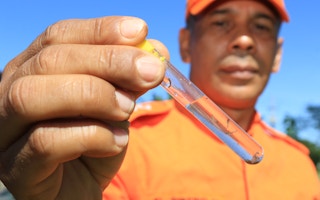Global warming will cause a catastrophic rise in mosquito-borne diseases such as dengue and chikungunya, spreading them to less affected places including Europe and the United States, a World Economic Forum (WEF) report said this month.
That is raising concern over global efforts to eradicate a host of debilitating neglected tropical diseases (NTDs) that still cause immense suffering among millions of the world’s poorest people, even though they can be prevented or cured.
What are neglected tropical diseases (NTDs)?
NTDs is a broad term that describes a group of 20 infectious illnesses, including dengue, lymphatic filariasis, soil-transmitted helminth infections, and trachoma. Many of them are vector-borne - spread by flies, mosquitoes and other insects - and mostly found in poor communities in tropical and subtropical regions of the world.
Altogether, more than a billion people are impacted by NTDs, according to World Health Organization (WHO) estimates, and they cause thousands of preventable deaths each year.
Many more people are blinded, disabled and disfigured due to the diseases, which perpetuate a cycle of poverty, keeping millions of children out of school and adults from work.
The diseases afflict those without access to clean water, sanitation and the basic health services required to protect people against infection by bacteria, viruses and other pathogens, meaning those living in poor, rural areas or conflict zones are at particular risk.
“
Any relative change in climate is huge because it could just give that edge to the vectors to sort of regain a foothold and become a little bit more difficult to manage. Climate could make it harder to control some NTDs.
Kris Murray, professor, London School of Hygiene and Tropical Medicine
What diseases are being fuelled by climate change?
Tropical disease experts say a resurgence of vector-borne diseases in areas where they were previously eliminated or controlled is imminent as climate changes raises global temperatures and disrupts rainfall patterns.
Heavy rains, for example, can flood urban waterways, turning them into favourable breeding grounds for mosquitoes, and a warmer climate accelerates the life cycle of parasites, thereby increasing their population.
Drought, meanwhile, can lead people and disease vectors to migrate elsewhere in search of water - causing NTDs to spread with them.
An additional 500 million people may be exposed to vector-borne diseases like malaria, dengue and Zika by 2050 as warmer temperatures speed up the geographical spread of mosquitoes to less affected regions like the U.S. and Europe, according to the report published at the WEF meeting in Davos earlier this month.
Ibrahima Socé Fall, director of the WHO’s Control of Neglected Tropical Diseases Department, said more than 100 countries are recording dengue transmission.
Contrasting the threat with Covid-19, he said “the next public health challenge may not be a respiratory disease but a vector-borne disease”.
What is being done to tackle NTDs?
So far, more than 50 countries have eliminated at least one NTD, and the WHO released its second 10-year plan in 2021 with the aim of eliminating at least one of the 20 recognised NTDs in 100 countries by 2030.
At the COP28 climate conference in Dubai in December, donors pledged US$777.2 million to fight NTDs and outlined goals including wiping out two of them - river blindness and lymphatic filariasis in Africa.
While past initiatives to combat the diseases have focused on providing free drugs and timely access to treatment, infectious disease specialists say the impact of climate change on NTDs should now be factored into disease elimination and control programmes.
“We know climate change will impact NTDs. What we don’t fully know is how or to what extent. But we can’t wait to act,” said Tala Al-Ramahi, from Reaching the Last Mile (RLM), a global health initiative leading the push against river blindness and lymphatic filariasis.
Fall said more data and research, for example on how heavy rainfall proliferates mosquito populations, could help prevent and predict outbreaks.
Adhering to the agreed-upon 1.5 degrees Celsius limit to curb emissions to address global warming could help mitigate the spread of vector-borne diseases, said Kris Murray, professor of environment and health at the London School of Hygiene and Tropical Medicine.
He said it may become more difficult to check the spread of NTDs if countries’ global emissions continue at current rates.
“Any relative change in climate is huge because it could just give that edge to the vectors to sort of regain a foothold and become a little bit more difficult to manage. Climate could make it harder to control some NTDs,” he said.
This story was published with permission from Thomson Reuters Foundation, the charitable arm of Thomson Reuters, that covers humanitarian news, climate change, resilience, women’s rights, trafficking and property rights. Visit https://www.context.news/.










